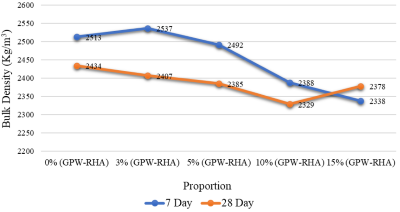Effectiveness of Rice Husk Ash and Glass Powder Waste as Partial Replacements of Cement in Concrete Construction
DOI:
https://doi.org/10.24036/cived.v11i3.625Keywords:
Replacement for Cement, Glass Powder Waste, Rice Husk Ash, Compressive Strength, Bulk DensityAbstract
The environmental impact of cement production has drawn attention to the use of glass waste and rice husk as a partial replacement for cement in concrete. According to research, the compressive strength of concrete containing GPW and RHA can increase up to 15-20%, after which it begins to decline. The objective of this study was to analyze the effectiveness of partial replacement of cement with GPW and RHA. Some of the factors considered in this study were compressive strength and specific gravity. The proportions of GPW and RHA used were 0%, 3%, 5%, 10%, 15%. Then concrete testing was done after 7 and 28 day. The maximum 28-day concrete compressive strength result for the addition of GPW and RHA at 5% mix proportion was 33.1 Mpa. The more the proportion of GPW and RHA mixture, the more the relative specific gravity of concrete decreases. Overall, this study found that the use of GPW and RHA in concrete had a significant effect on compressive strength and specific gravity. But do not forget to pay attention to how much GPW and RHA mix needs and the quality of concrete to be achieved.
Downloads
References
S. Ahmadi, “Effect of glass waste as a cement replacement on the mechanical properties of concrete,” Synth. Sinter., vol. 2, no. 3, pp. 125–130, 2022, doi: 10.53063/synsint.2022.23120.
G. Kashyap and R. Bajaj, “Performance Analysis of Concrete Strength By Partially Admission of Glass Powder In Concrete,” vol. 8, no. 1, pp. 72–76, 2020.
A. G.elmikass, M. H. Makhlouf, T. S. Mostafa, and G. A. Hamdy, “Experimental Study of the Effect of Partial Replacement of Cement with Glass Powder on Concrete Properties,” Key Eng. Mater., vol. 921, no. March 2023, pp. 231–238, 2022, doi: 10.4028/p-m8qo9w.
F. Muleya, N. Muwila, C. K. Tembo, and A. Lungu, “Partial replacement of cement with rice husk ash in concrete production: An exploratory cost-benefit analysis for low-income communities,” Eng. Manag. Prod. Serv., vol. 13, no. 3, pp. 127–141, 2021, doi: 10.2478/emj-2021-0026.
H. E. Abdelli, S. Kennouche, J. L. B. De Aguiar, and C. Jesus, “The Combined Effect of Glass and Plastic Waste on Concrete Properties: Experimental Study,” Period. Polytech. Civ. Eng., pp. 1–10, 2024, doi: 10.3311/ppci.23337.
M. O. Yusuf et al., “Microstructural Characteristics, Modeling of Mechanical Strength and Thermal Performance of Industrial Waste Glass Blended Concrete,” Appl. Sci., vol. 12, no. 17, pp. 1–21, 2022, doi: 10.3390/app12178600.
World Health Organization, Progress on Household Drinking Water, Sanitation and Hygiene 2000-2020 Five years into the SDGs. 2021.
R. H. S, “Partially Replacement of Cement by Waste Glass Powder in Concrete,” Int. J. Sci. Res. Comput. Sci. Eng. Inf. Technol., vol. 4, no. 9, pp. 116–120, 2019.
A. Bouty and F. Homsi, “The effects of partially replacing cement by glass waste powder on concrete properties,” Epa. - J. Silic. Based Compos. Mater., vol. 73, no. 2, pp. 40–43, 2021, doi: 10.14382/epitoanyag-jsbcm.2021.7.
S. Rahman and M. N. Uddin, “Experimental investigation of concrete with glass powder as partial replacement of cement,” Civ. Eng. Archit., vol. 6, no. 3, pp. 149–154, 2018, doi: 10.13189/cea.2018.060304.
Ö. Zeybek et al., “Influence of Replacing Cement with Waste Glass on Mechanical Properties of Concrete,” Materials (Basel)., vol. 15, no. 21, 2022, doi: 10.3390/ma15217513.
A. Rathi and N. Hooda, “A Study on Effect of Fly Ash and Glass Powder on the Compressive Strength and Permeability of Concrete,” Int. J. All Res. Educ. Sci. Methods, vol. 4, no. 7, pp. 2455–6211, 2016, [Online]. Available: https://www.ijaresm.com/uploaded_files/document_file/Amarjeet_Rathi_1Fmop.pdf.
B. A. Tayeh, “Effects of marble, timber, and glass powder as partial replacements for cement,” J. Civ. Eng. Constr., vol. 7, no. 2, p. 63, 2018, doi: 10.32732/jcec.2018.7.2.63.
S. A. Endale, W. Z. Taffese, D. H. Vo, and M. D. Yehualaw, “Rice Husk Ash in Concrete,” Sustain., vol. 15, no. 1, pp. 1–29, 2023, doi: 10.3390/su15010137.
A. Alhassan, A. Aboshio, and O. A. Uche, “Rice Husk and Snail Shell Ash As Partial Replacement of Ordinary Portland Cement in Concrete – a Review,” Niger. J. Technol., vol. 42, no. 4, pp. 425–436, 2023, doi: 10.4314/njt.v42i4.2.
A. A. Ghayuori and A. S. Rana, “Effect of partial replacement of Portland Cement with fly Ash, Rice Husk Ash and Bagasse Ash on chemical and mechanical properties of concrete,” Int. Res. J. Eng. Technol., vol. 8, no. 1, pp. 11–15, 2021, [Online]. Available: http://www.dynamicpublisher.org/gallery/ijsrr-d667.pdf.
V. Patil and P. M. C. Paliwal, “Partial Replacement of Cement Concrete with Rice Husk Ash,” Int. J. Innov. Technol. Explor. Eng., vol. 8, no. 12S, pp. 1061–1063, 2019, doi: 10.35940/ijitee.k1292.10812s19.
K. C. Aremu, “Utilization of Rice Husk Ash on Pervious Concrete As a Partial Replacement of Cement,” Int. J. Eng. Sci. Res. Technol., vol. 9, no. 10, pp. 41–48, 2020, doi: 10.29121/ijesrt.v9.i10.2020.4.
A. Siddika, M. A. Al Mamun, R. Alyousef, and H. Mohammadhosseini, “State-of-the-art-review on rice husk ash: A supplementary cementitious material in concrete,” J. King Saud Univ. - Eng. Sci., vol. 33, no. 5, pp. 294–307, 2021, doi: 10.1016/j.jksues.2020.10.006.
N. Bheel, A. A. Dayo, A. W. Abro, S. Shaikh, I. A. Shar, and Z. H. Shaikh, “Use of Rice Husk Ash as Cementitious Material in Concrete,” Eng. Technol. Appl. Sci. Res., vol. 9, no. 3, pp. 4209–4212, 2019, doi: 10.48084/etasr.2746.
P. Y. Putri, I. Kamil, A. Rizandi, E. P. Education, U. Andalas, and U. N. Padang, “The Effect of Rice Husk Ash as Cement Substitution on the Compressive Strength of Self-Compacting Concrete,” vol. 11, no. 2, pp. 550–557, 2024.
Badan Standardisasi Nasional, Tata Cara Pembuatan Rencana Campuran Beton Normal SNI 03-2834-1992. 2000.

Downloads
Published
Issue
Section
License
Copyright (c) 2024 Tedy Pranadiarso, Imam Junaidi, Slamet Rohadi Budi Prasetyo, Adinata Laksana Putra

This work is licensed under a Creative Commons Attribution 4.0 International License.

